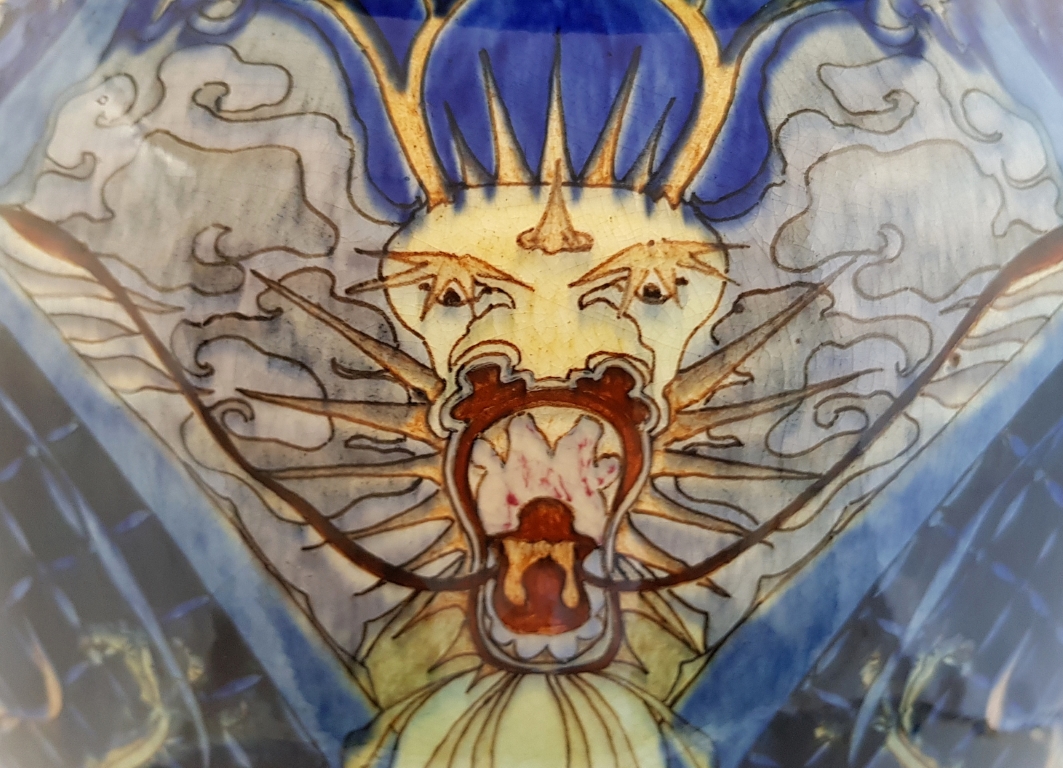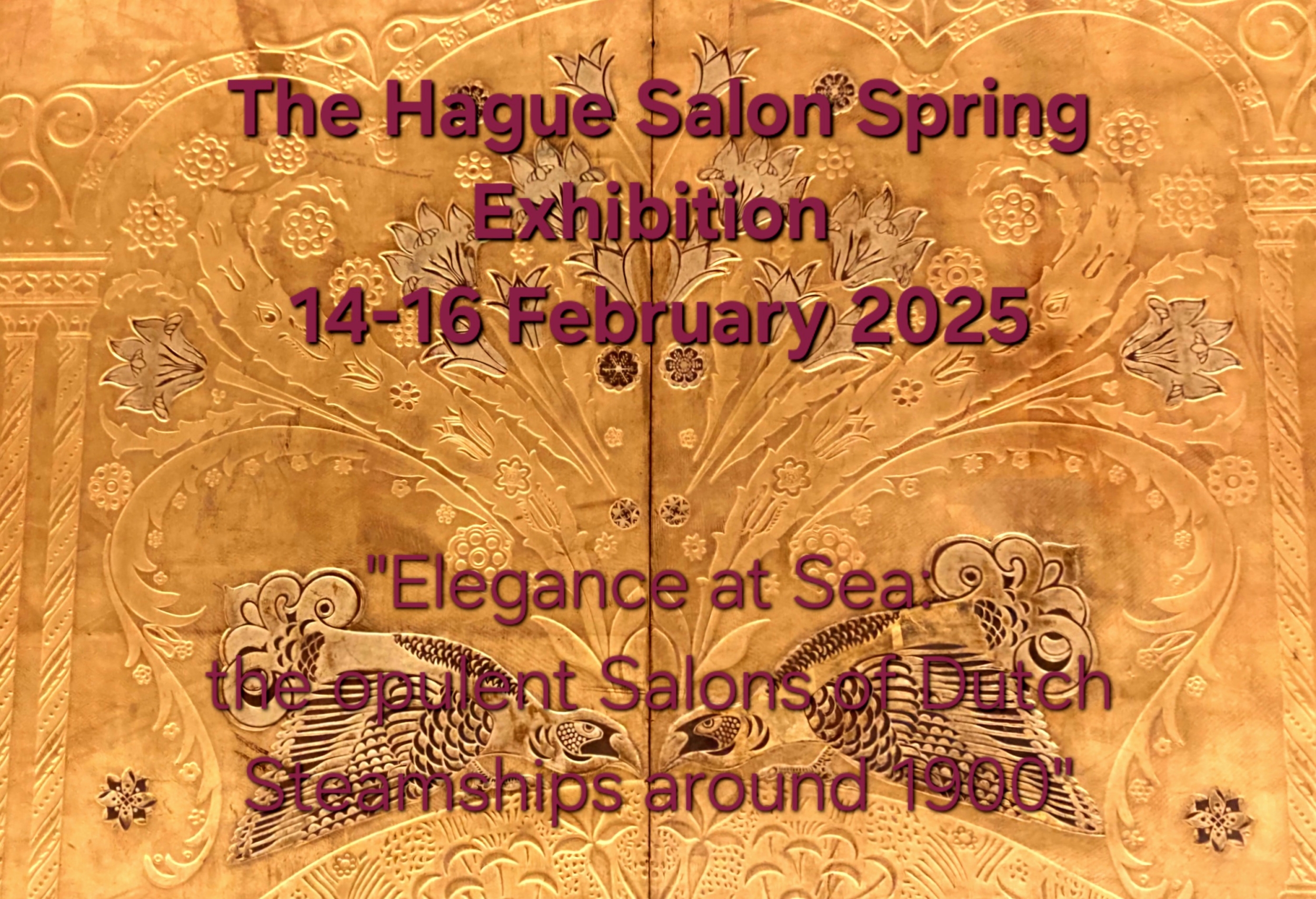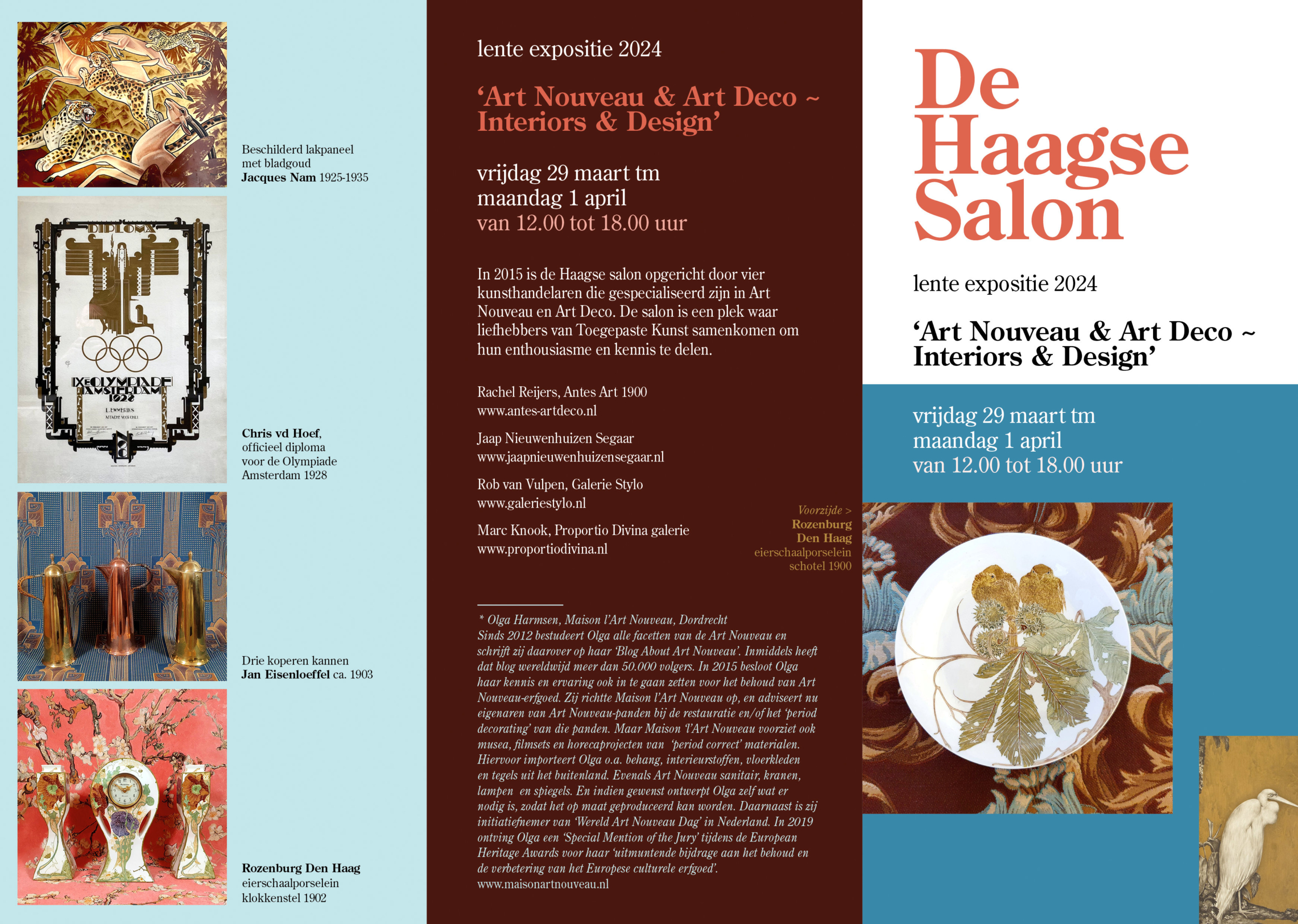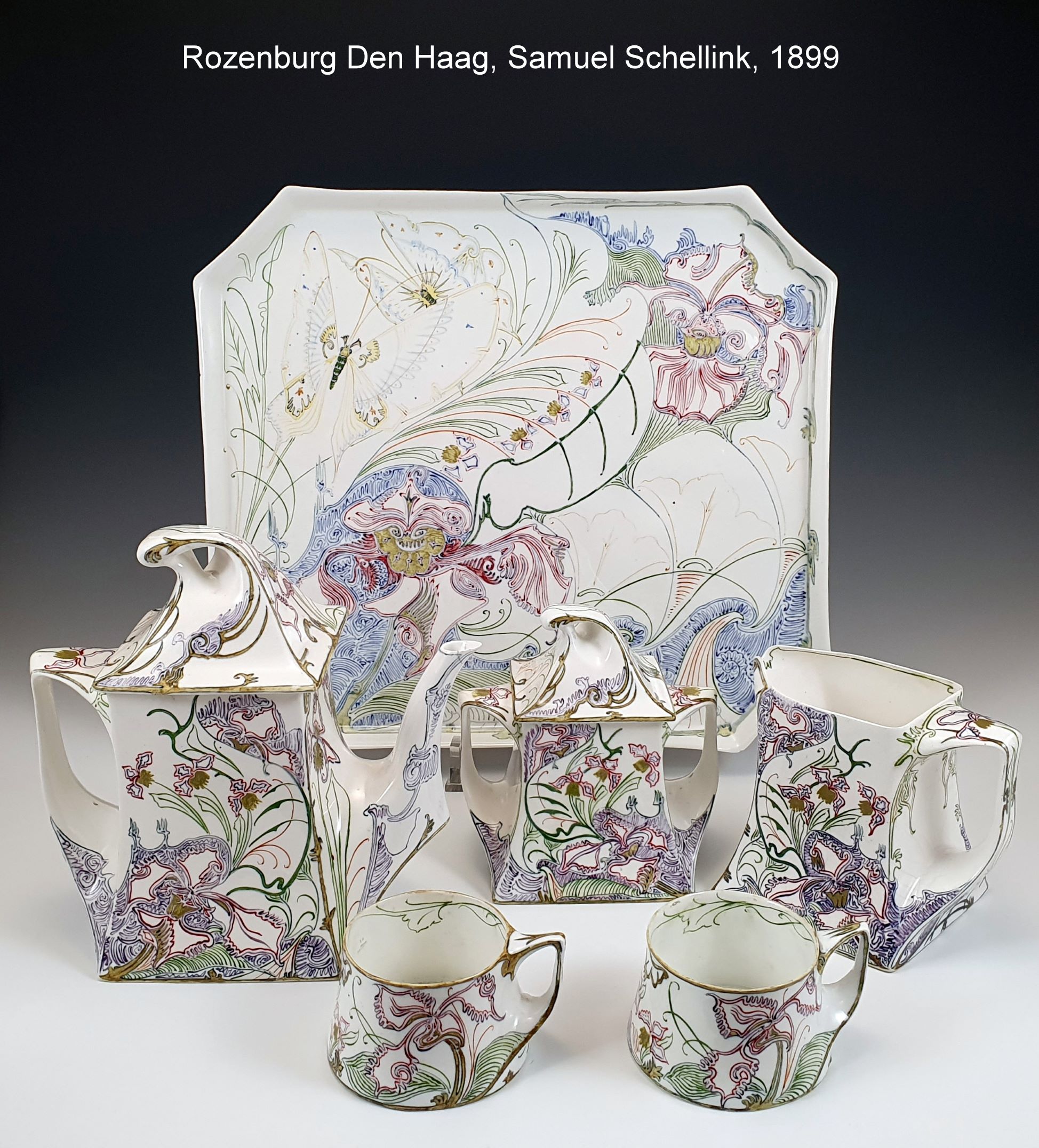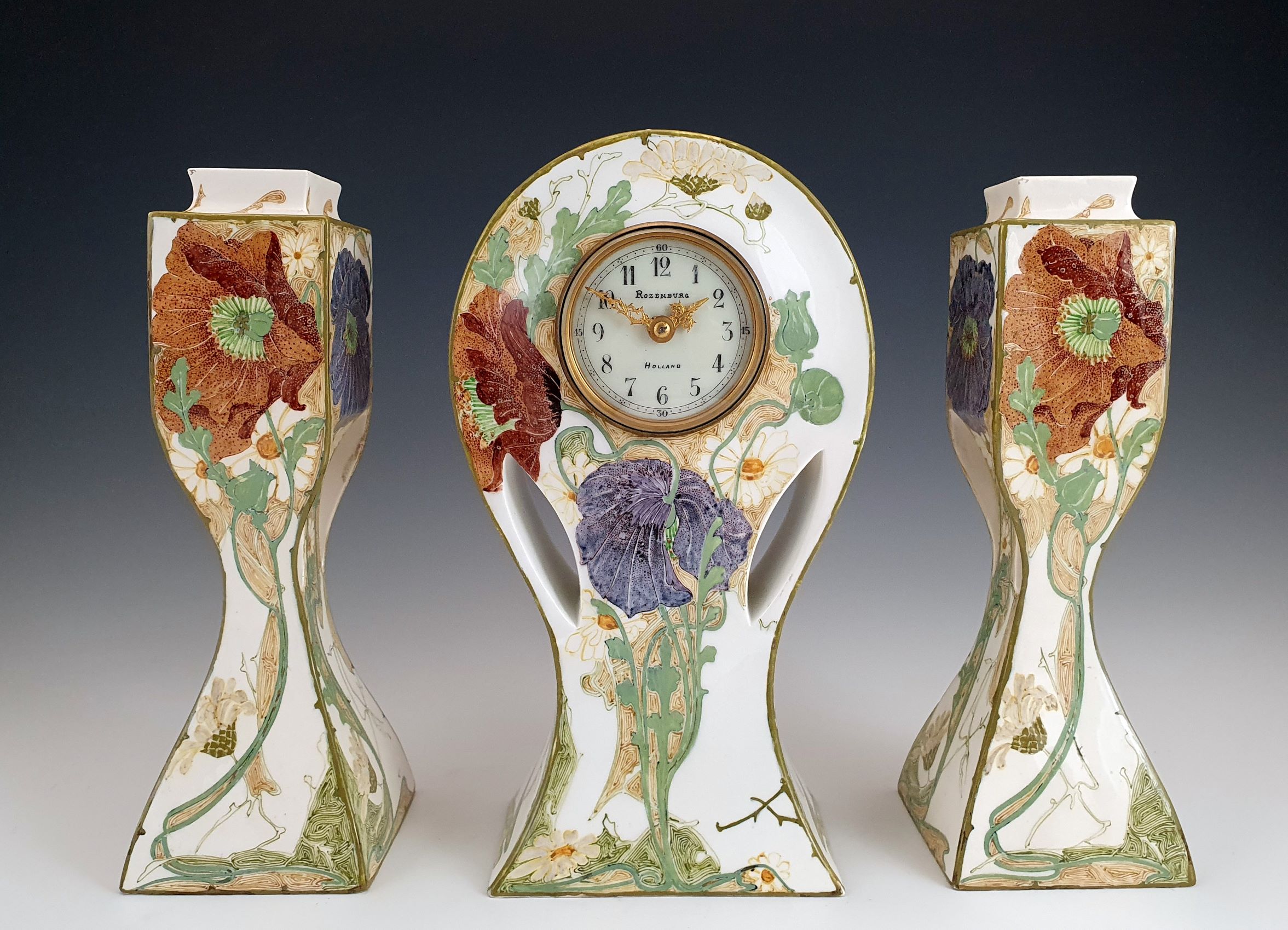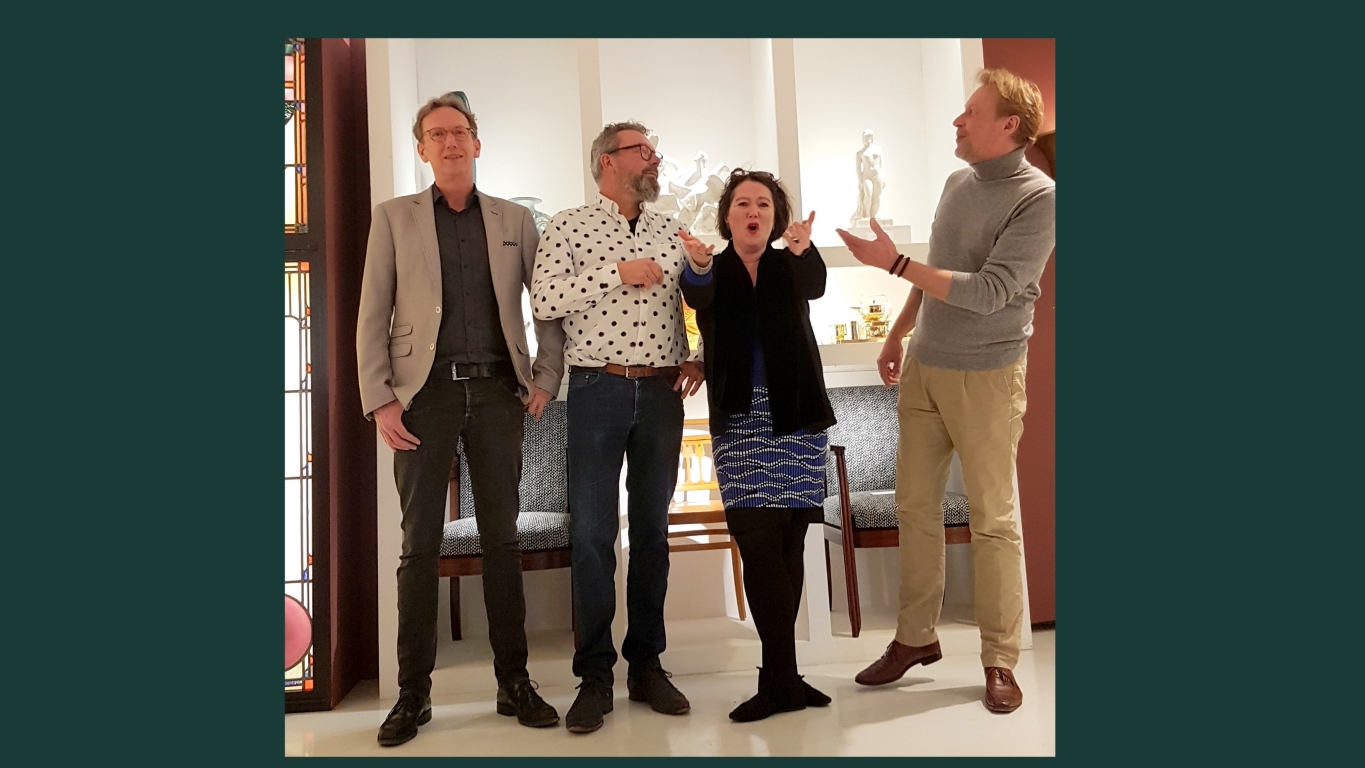Rozenburg Den Haag, 1896
This 46 cm high Rozenburg earthenware vase (model 71 ‘Japanese Vase’) was painted by Willem Frederik Haas and Samuel Schellink between 19 and 26 September 1896. However, the remarkable decorative design is most likely made by Dominicus de Ruiter. De Ruiter was appointed chef of the Rozenburg painting studio in August that year. He underwent education at the Academy of Visual Arts and worked as lithographer prior to his arrival at Rozenburg (source: Yvonne Brentjens, ‘Rozenburg Earthenware from The Hague circles’, page 119).
Japonism
Famous art dealer Siegfried Bing opened his art dealership “L’Art Nouveau Bing’ a year earlier, in 1895. Bing had been a long time dealer in Japanese artefacts and prints, and when the West became enthralled by Japanese art and a true Japan mania started in 1880, Bing cleverly responded to it. He travelled to Japan, where he opened import and export companies in Yokohama and Kobe.
Bing’s imported Japanese prints had a particularly big impact on European artists. Even Vincent van Gogh was a keen buyer. Bing launched ‘Le Japon Artistique’ in 1888, a magazine filled with articles mainly about artworks from his own collection. In the first issue, Bing describes Japanese art as ‘Art Nouveau’, a New Art, which would have a lasting and alluring influence on Western art.
This statement proved prophetic, as Western artists later created their own movement based on Japanese art called Japonism, which turned out to be the birthplace of Art Nouveau as we know it.
Anton Seder (Munich, 1850-1916 Strasbourg)
German artist and art professor Anton Seder founded the ‘École supérieure des arts décoratifs’ in Strasbourg in 1892. Anton Seder’s goal for the school was to become an influential artistic force in the Elzas-Lotharingen region. His works transcended the boundaries of the French and German art styles and was a major influence on the development of Art Nouveau.
In the spring of 1896, Anton Seder’s important and later world famous work “Das Their in der dekorativen Kunst” was published. The first part, ‘die Wasserthiere’, included richly decorated pages with illustrations of dragons, in particular the so-called Japanese water dragons.

Inspiration
A famous quote by Anton Seder was “…that is why we, when we look at the newest creations of our most modern designers in craftwork, inadvertently say: everything has already been done”
It is clear that Seder’s drawings of dragons were a major influence on the newly appointed chef of the Rozenburg painting studio, Dominicus de Ruiter. It also shows how Rozenburg capitalized on the current trends and got inspired by international publications, see also : https://proportiodivin.wpengine.com/en/object/rozenburg-den-haag-1895/ and:https://proportiodivin.wpengine.com/en/object/rozenburg-den-haag-1899/
One of the most iconic pieces of Rozenburg earthenware is a large wall plate from 1896, decorated with dragons. The large dragon, in the center of the plate, is literally derived from the cover of “Das Their in der dekorativen Kunst”.
However, the plate was painted a month after the large vase, between 24 and 31 October 1896.

The decoration
The design of the large plate with the ferocious dragon is purely decorative, but the design of the vase shows more. When looked at from a distance, one can see 4 large poppy heads. The base of each poppy head is shaped by two dragons spitting at each other. At the top, between each poppy head, a fierce dragon looks straight at you, surrounded by billowing grey clouds of smoke.
You can also see two Japanese masks. The large poppy head resembles a mask with a friendly smile, with eyes shaped by the curling green tails of the dragons. The other, rather intimidating mask can be seen at the side with de fierce dragon. In each poppy head, one can see a net-like pattern, trapping the Japanese water dragons in the poppy head.
Opium: “Chasing dragons”
Even more remarkable is the decoration on the inside of the vase. The inside has been painted with several tiny poppy heads, all the way to the bottom. And the pleasure with which that is done literally drips from it! While the instructions on the outside of the vase were still somewhat subtle, the inside betrays the actual subject of the decor: ‘chasing dragons’. Chasing dragons refers to the habit of smoking opium, a rather popular custom at the end of the 19th century.
This sheds a new light on the decoration on the outside of the vase. When looked at the object between the two blue dragons, it resembles a opium lamp or opium burner. At the centre, one can see an abstract, red pattern that looks like fire, with swirling smoke at the sides. It also explains the billowing grey clouds of smoke surrounding the fierce dragons at the top.
Signature, the marks
The vase has the painter’s mark of Willem Frederik Haas. It is however highly unlikely that he designed the décor. He just turned 18 in September 1896 and was promoted to painter. Furthermore, neither Samuel Schellink nor Willem Haas worked on the large plate with the dragon decoration a month later. Both designs must have been by Dominicus de Ruiter. Never before had we seen an object like this in the Dutch Art Nouveau, depicting or referencing smoking or using opium.
The label at the bottom of the vase is also remarkable. It shows that the vase was sold by the exclusive Parisian store ‘Porcelaines a La Paix’, situated at the equally exclusive Avenue de l’Opera 34.
Dragons at other Dutch earthenware factories
As far as we have been able to ascertain, this large Rozenburg vase from September 1896 was the first and earliest Dutch Art Nouveau object decorated with dragons. Dominicus de Ruiter started a real craze with this one! Since the autumn of 1896, more and more variations on these dragon designs appeared. When Rozenburg started manufacturing their later worldfamous eggshell porcelain in March 1899, they also used dragon decorations, even on entire coffee and teaservices, see: www.kunstmuseum.nl/en/collection
Fairly quickly, other porcelain factories started producing vases and plates with dragons. Strikingly, these were former Rozenburg painters continuing the dragon rage in other factories.
One of these painters was Chris Lanooy, who started working as a porcelain painter at Rozenburg on September 12th 1896, for over a year. Years later, around 1904, he worked as porcelain painter and designer at the Haga Purmerend factory. He designed and painted amazing dragons for Haga, and even added an extra dimension: dragons ‘captured’ under lustre glaze.
Amphora Holland Fayence factory in Oegstgeest also executed dragons captured under luste glaze. Both Roelof Sterken and Samuel Schellink started working at Amphora. Because Roelof Sterken probably started working at Amphora earlier than Schellink, around 1908, he would have given the impetus for decors with dragons. These dragons had more in common with the dragons designed by Chris Lanooy for Haga around that time.
Johannes Cornelis Heijtze and Johannes Karel Leurs left Rozenburg for the Holland Fayence factory of Jan Willem Mijnlieff as early as spring 1896. There, exuberant dragons were painted on wall plates and vases in the Rozenburg style.
All these porcelain painters were working at Rozenburg in her glory year 1896!
